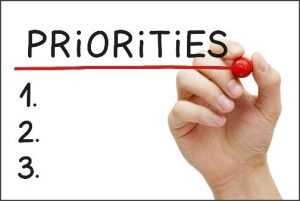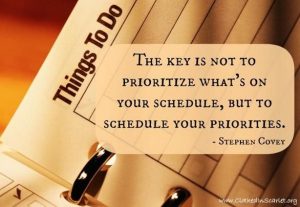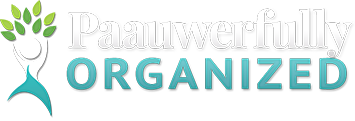In last week’s blog, Capturing that Elusive Thing Called Time, you learned about a tool to help you sort out how much of your time you spend doing activities that are important or not important to you. This week in the USA, we’ll celebrate Independence Day on July 4th. I can’t think of a better way to declare and claim your independence than to take control of the way you manage your use of the 168 hours you are given each week. Keep reading to access a weekly planning process – a transformational key to reclaiming your life by making conscious choices about how you spend your time.
“The greatest value of the planning process is not what it does to your schedule, but what it does to your head. As you begin to think more in terms of importance, you begin to see time differently. You become empowered to put first things first in your life in a significant way.” –Stephen Covey, The Seven Habits of Highly Effective People
Let’s revisit my clients, Carol and Marilyn (not their real names), whom I wrote about last week. Carol has fully embraced the weekly planning process that I taught her. She is noticeably more at peace now than she was when we first started working together. Her quality of life has dramatically improved as she has clarified priorities and has done weekly planning to ensure that she focuses her time on Quadrant I and II activities and avoids Quadrant III and IV activities. (Last week’s blog discusses these four quadrants.)
 Marilyn has not reserved time for planning. She is too busy putting out fires (Quadrant I and III activities) to spend time planning for the coming week (a Quadrant II activity). The more she neglects Quadrant II activities — relationship-building, self-care, values clarification, and planning her schedule to accommodate what is most important in her life — the more urgent (Quadrant I) activities she has to deal with.
Marilyn has not reserved time for planning. She is too busy putting out fires (Quadrant I and III activities) to spend time planning for the coming week (a Quadrant II activity). The more she neglects Quadrant II activities — relationship-building, self-care, values clarification, and planning her schedule to accommodate what is most important in her life — the more urgent (Quadrant I) activities she has to deal with.
When we neglect activities in Quadrant II long enough, they often become Quadrant I. Marilyn generates her own fires and then feels compelled to put them out, thus filling her schedule with more urgent activities. When urgency rules, stress levels go up, and we don’t feel that we have any choice about how we spend our time.
Have to vs. Choose to
Another client recently began our coaching call by sharing her frustration about not having enough time. She went on to list all of the things that she had to do that day. After hearing her say “I HAVE to” several times, I asked her, “Do you CHOOSE to do all these things you’ve just listed?” She recognized that she did not have to do any of them…and that she chose to do most of them.
 As my client thought about it, she decided that she would choose to either delegate or not do one of the things on her list, which had previously felt like a have to. The realization that these activities were a choice completely shifted how she felt about doing them.
As my client thought about it, she decided that she would choose to either delegate or not do one of the things on her list, which had previously felt like a have to. The realization that these activities were a choice completely shifted how she felt about doing them.
Language is very powerful as you do your planning. Be aware of your self-talk as you make choices for the week. Listen especially for should, gotta, and have to in your self-talk. Those trigger words may signal that you may not be feeling at choice, even though you are the one who chooses what you prioritize.
Transformational Process
Stephen Covey has created a six-step weekly planning process. When done weekly, it will transform your life. I’ve found that this process does not work nearly as well if I skip any of the six steps:
- Review your own personal life mission or purpose.
- Review your key roles, beginning with SELF.
- Identify what you choose to do this week in each of your key roles.
- Schedule into your calendar the choices you identified in Step 3.
- Exercise integrity in the moment of choice as you live your week.
- At the end of the week, evaluate how your week went before you prepare for the coming week.
To review this planning process in greater detail, I invite you to register for my free webinar, Managing Priorities. You will also find a printable expanded review of it here. This weekly planning process has transformed my life, as well as the lives of many of my clients.
People are motivated to change by two things: the ability to increase pleasure or decrease pain. Weekly planning is a tool that has the capacity to help you increase pleasure and decrease pain in your life.
 I challenge you to go to your calendar NOW and schedule one hour a week for the next month — preferably at the same time each week — to do your weekly planning, using all six steps outlined above. Focus on Quadrant I and II activities as you plan. The quality of each week will increase and you’ll feel a much greater sense of accomplishment because you will have heightened your focus on what’s most important to you.
I challenge you to go to your calendar NOW and schedule one hour a week for the next month — preferably at the same time each week — to do your weekly planning, using all six steps outlined above. Focus on Quadrant I and II activities as you plan. The quality of each week will increase and you’ll feel a much greater sense of accomplishment because you will have heightened your focus on what’s most important to you.
If you’d like a fresh perspective– someone to help you get started with a weekly planning process that aligns with your vision, priorities, and actions—let’s schedule a no-cost, no-pressure Discovery Call today.
Additional Resources
- Time Analysis Tool: 168 Hours
- Blog: Capturing that Elusive Thing Called Time
- Blog: Six Step Weekly Planning Process
- Blog: Creating an Effective Weekly Schedule Template
- Blog: Overcome Procrastination
- Blog: Balance Your Life: The Nine Environments of You
- Free Webinar: Managing Priorities
- Free eBook: 7 Strategies to Overcome Overwhelm
- Guide: Dealing with Procrastination
- Guide: Simple Strategies to Increase Your Productivity











Kathy, this was great. Thank you for sharing! Have a wonderful 4th too!